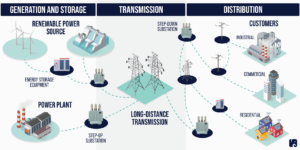Energy Security
Energy security can be defined as the ability to maintain a consistent supply of energy at a sustainable price. The key terms of this definition are “consistent supply” and “sustainable price.” Anything affecting the ability of the U.S. to accumulate or distribute energy poses an energy security risk. The U.S. can increase domestic production and diversify its energy sources to insulate it from price shocks and strengthen energy security. However, there are many physical risks associated with energy security, particularly for the grid, which is a vital component of U.S. energy security. With disruptions to the grid felt immediately, it has been increasingly in focus as the nation attempts to transition to net-zero carbon emissions.
In February 2021 a winter storm knocked out the Texas power grid. Millions of Texans lost power for multiple days in the freezing temperatures and 702 people died as a result of the storm. The Department of Energy has admitted that the clean energy transition is already pushing the energy grid beyond its limits; the grid was not designed around maximizing alternative energy sources. The grid faces external risks as well. Some of the largest threats are extreme weather, cybersecurity, and wildlife. A modernized energy grid is critical for U.S. energy security and resilience.
The Energy Grid

Energy Grid Infrastructure, Photo Credit US Senate Republican Policy Committee
The term “energy grid” refers to the electrical grid that generates and supplies power to the U.S. There are three elements to the grid: generation, transmission, and distribution. Consequently, all power plants, power lines and other forms of distribution are essential for the energy grid and thus, energy security. Generally, distribution is the most vulnerable part of the energy grid as this infrastructure is most affected by extreme weather and most vulnerable to cyber-attacks.
Threats to Energy Security
Extreme Weather
Natural disasters like tornadoes, hurricanes and storms can clearly affect the energy grid. Protracted periods of extreme heat or cold, however, also strain the grid as Americans adjust the thermostat in their homes to escape the elements. In June 2021, unusually hot summer temperatures put the Texas grid under enormous pressure from record-high demand. The Electric Reliability Council of Texas had to ask Texans to conserve energy by reducing electricity use. Extreme weather conditions are the most common cause of energy disruptions in the U.S. The growing effects of climate change is exacerbating this risk. The Environmental Protection Agency (EPA) estimates that extreme weather events like heat waves, floods and droughts are becoming increasingly frequent. Additionally, major power outages from weather related events in the U.S. increased by approximately 67% since 2000.
Cybersecurity
Cybersecurity is an increasingly pressing energy security risk because the energy grid relies largely on automated systems that are vulnerable to cyber-attacks. The 2020 Homeland Threat Assessment from the Department of Homeland Security stated that China has the capability and possible intent to compromise the energy grid. This concern was reiterated in the 2021 threat assessment from the Office of the Director of National Intelligence, which stated that Russia, China, Iran and North Korea have the capability to cause harm to the energy grid. Energy Secretary Jennifer Granholm confirmed these fears in June 2021, stating that America’s adversaries possess the capability to shut down the grid. This suggests that the risks associated with energy security go beyond America’s domestic ability to maintain a consistent supply of power and may be a source of future geopolitical conflict. In April 2021, the Senate introduced a bipartisan bill to incentivize investments into cybersecurity technologies to protect the energy grid.
Wildlife
Wildlife poses another notable threat to the energy grid. Wildlife is responsible for the second most power outages in the U.S., second only to weather. Smaller power outages caused by squirrels, falling trees, birds etc. quickly accumulate to be a notable source of disruption. One database has compiled all the animal related power outages from 1987-2019. They estimated that there have been approximately 2,524 animal related power outages during that timeframe, with squirrels responsible for over half of this number. That equates to roughly 6 disruptions per month, for 32 years straight. Additionally, a hotter climate is damaging trees, making power lines more susceptible to tree damage. To respond to these risks, the Pacific Gas and Electric Company (PC&E) is spending $15 billion to bury power lines and protect them from wildlife related disruptions.
Energy Resilience
Energy security sits at the intersection of climate change, geopolitics, and national security. Modernizing the energy grid is a critical step in increasing resilience, meeting emissions targets, and strengthening energy security. Modernizing includes projects like microgrids, improved energy storage, and updated grid hardware. In April 2021, the Departments of Energy and Transportation announced renewed efforts to expand the national grid and modernize existing infrastructure. Energy security goes beyond America’s efforts to protect itself from price shocks and energy generation. Energy security also means protecting America’s infrastructure from threats like extreme weather, wildlife, and cybersecurity to ensure that Americans have uninterrupted access to power.







